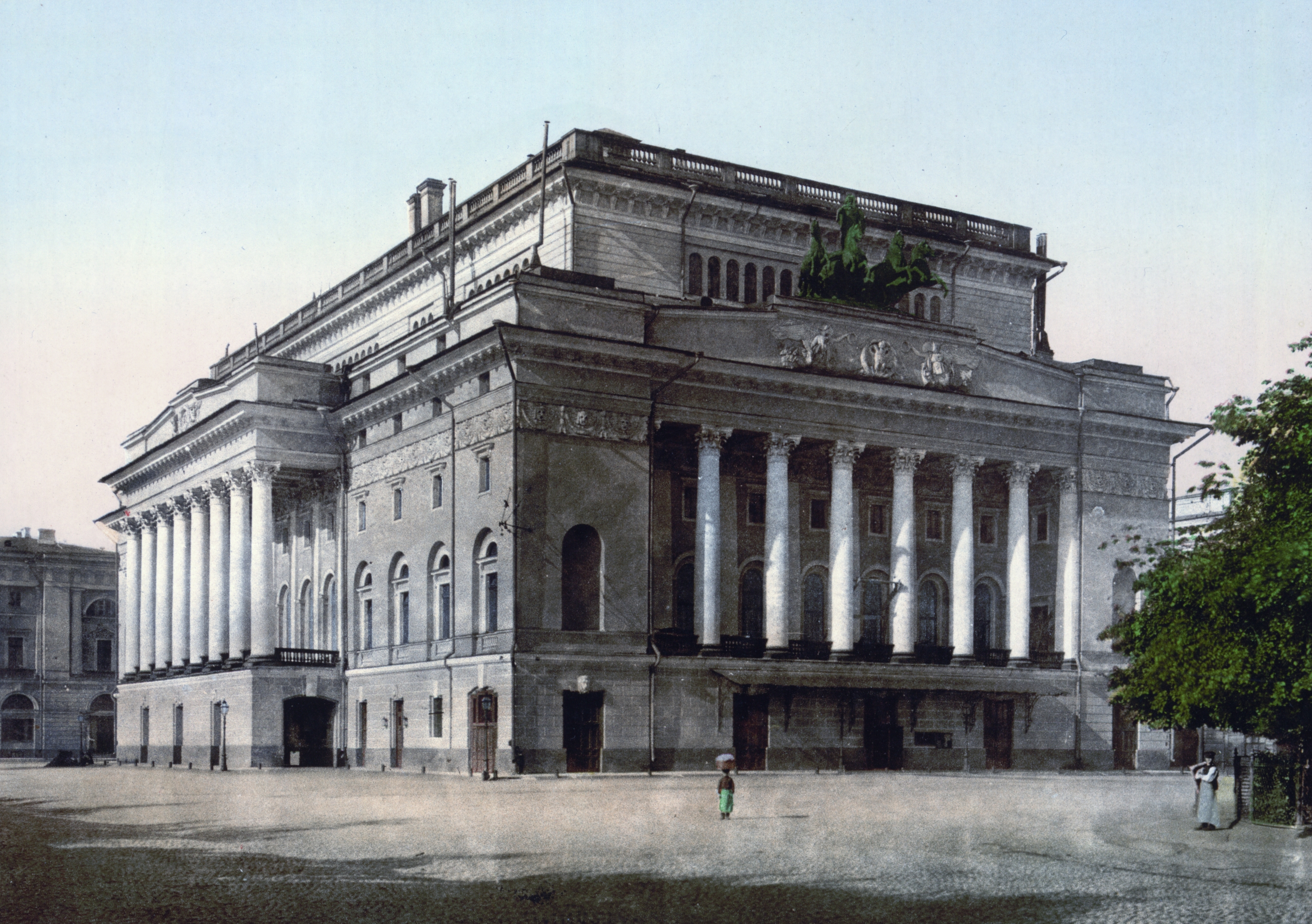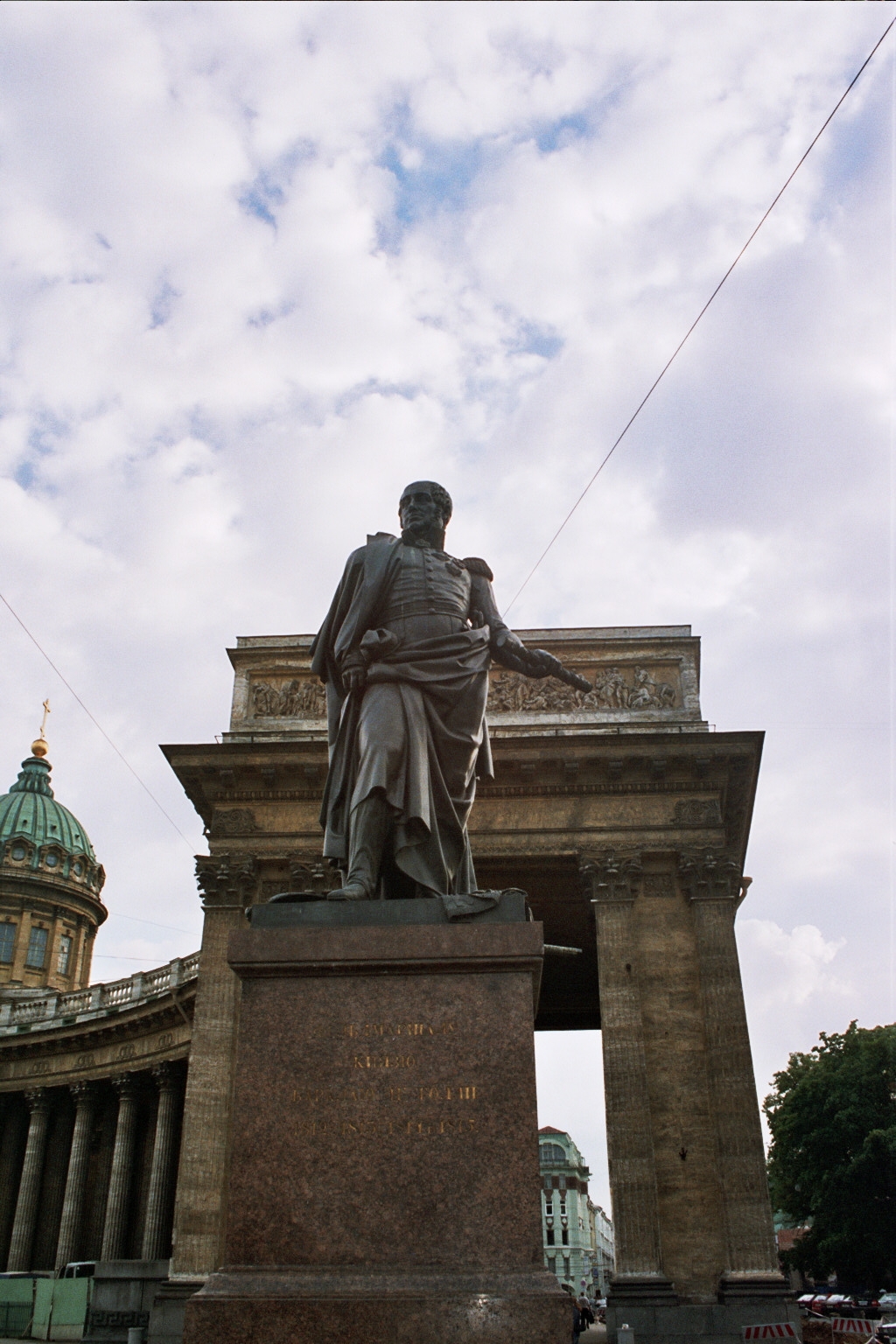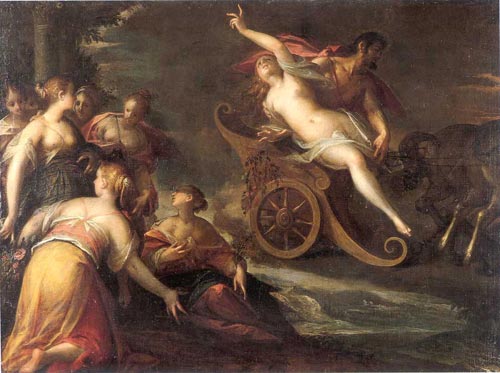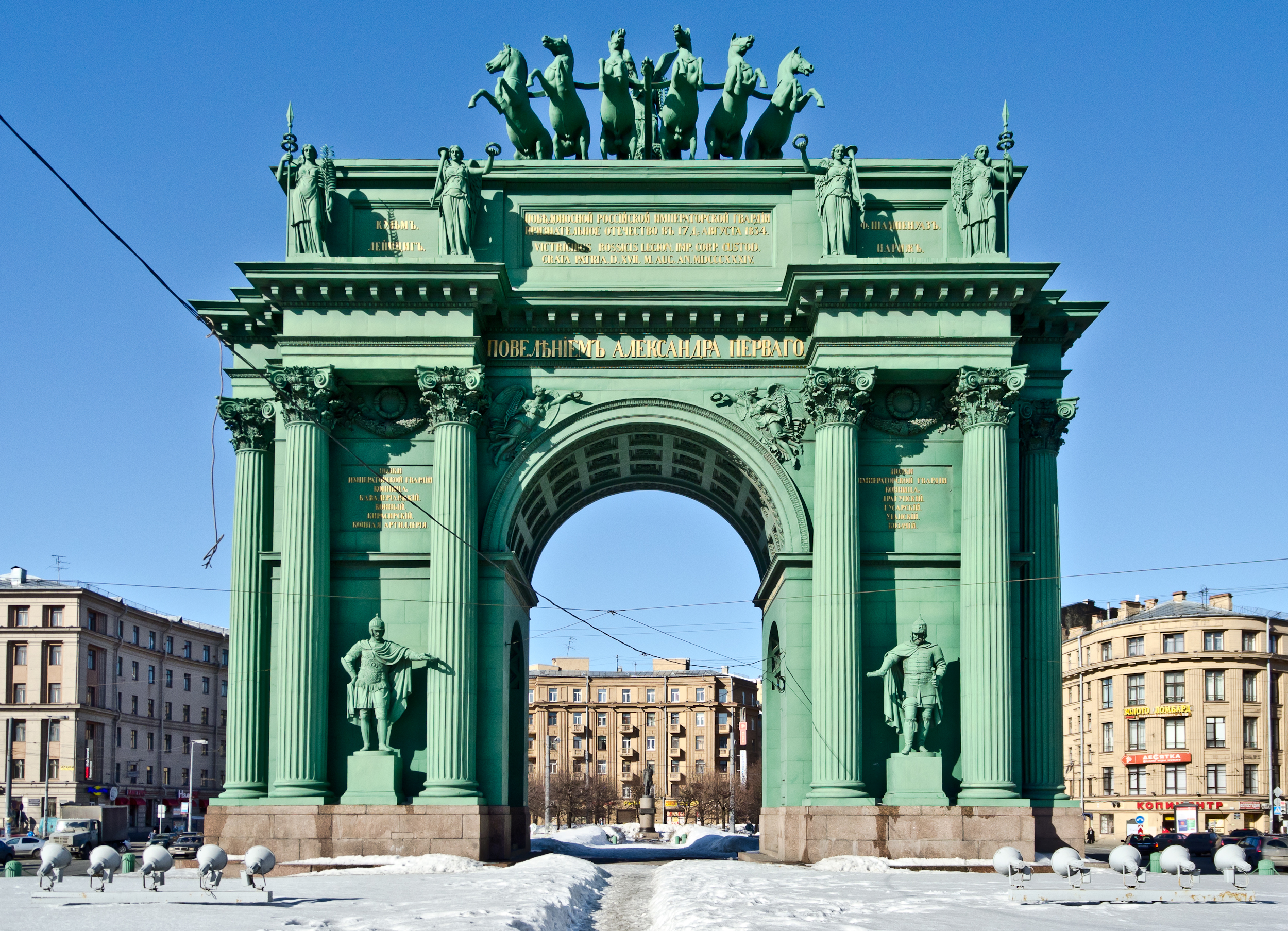|
Vasily Demut-Malinovsky
Vasily Ivanovich Demut-Malinovsky was a Russian sculptor whose works represent the quintessence of the Empire style. Biography He entered the Imperial Academy of Arts at the age of six and studied under Mikhail Kozlovsky for fifteen years. Upon the death of his teacher, he won a competition to design his tomb and departed for Rome to study with Canova. Success came to him with two colossal statues for the Kazan Cathedral in St Petersburg. In the aftermath of the Russian victory over Napoleon, Demut-Malinovsky executed a number of patriotic pieces, including a tomb and a large statue of Barclay de Tolly in Estonia. Later Alexander I assigned to him the task of preparing bas-reliefs symbolizing the Neva and the Volga for the Alexander Column on Palace Square. Demut-Malinovsky also designed statuary and decorations for other St Petersburg churches, palaces, and public monuments, especially those designed by Carlo Rossi: the General Staff Building, the Bourse, the Admiralty, the ... [...More Info...] [...Related Items...] OR: [Wikipedia] [Google] [Baidu] |
Saint Petersburg
Saint Petersburg ( rus, links=no, Санкт-Петербург, a=Ru-Sankt Peterburg Leningrad Petrograd Piter.ogg, r=Sankt-Peterburg, p=ˈsankt pʲɪtʲɪrˈburk), formerly known as Petrograd (1914–1924) and later Leningrad (1924–1991), is the second-largest city in Russia. It is situated on the Neva River, at the head of the Gulf of Finland on the Baltic Sea, with a population of roughly 5.4 million residents. Saint Petersburg is the fourth-most populous city in Europe after Istanbul, Moscow and London, the most populous city on the Baltic Sea, and the world's northernmost city of more than 1 million residents. As Russia's Imperial capital, and a historically strategic port, it is governed as a federal city. The city was founded by Tsar Peter the Great on 27 May 1703 on the site of a captured Swedish fortress, and was named after apostle Saint Peter. In Russia, Saint Petersburg is historically and culturally associated with t ... [...More Info...] [...Related Items...] OR: [Wikipedia] [Google] [Baidu] |
Carlo Rossi (architect)
Carlo di Giovanni Rossi (''Karl Ivanovich Rossi''; russian: Карл Иванович Росси; – ) was an Italian architect who worked in Imperial Russia. He was the author of many classical buildings and architectural ensembles in Saint Petersburg and its environs. Biography Carlo Rossi was born in Naples (his stepfather was the famous ballet artist Charles le Picq) and was brought to Russia in his childhood when his mother Guertroude Rossi-Le Picq, a well-known ballerina, was invited into Russia to perform. From youth he was connected with the world of the arts. He trained in the studio of architect Vincenzo Brenna. In 1795 he entered the service of the admiralty board of architecture; as the assistant to Brenna, together with whom, it is assumed, he participated in the construction of Saint Michael's Castle in Saint Petersburg. From 1802 to 1803 Rossi studied in Italy. In 1806 he obtained the title of architect and an office. In 1808 he was dispatched to the Kreml ... [...More Info...] [...Related Items...] OR: [Wikipedia] [Google] [Baidu] |
Alexander Suvorov
Alexander Vasilyevich Suvorov (russian: Алекса́ндр Васи́льевич Суво́ров, Aleksándr Vasíl'yevich Suvórov; or 1730) was a Russian general in service of the Russian Empire. He was Count of Rymnik, Count of the Holy Roman Empire, Prince of the Kingdom of Sardinia, Prince of the Russian Empire and the last Generalissimo of the Russian Empire. Suvorov is considered one of the greatest military commanders in Russian history and one of the great generals of the early modern period. He was awarded numerous medals, titles, and honors by Russia, as well as by other countries. Suvorov secured Russia's expanded borders and renewed military prestige and left a legacy of theories on warfare. He was the author of several military manuals, the most famous being ''The Science of Victory'', and was noted for several of his sayings. He never lost a single battle he commanded. Several military academies, monuments, villages, museums, and orders in Russia are dedicate ... [...More Info...] [...Related Items...] OR: [Wikipedia] [Google] [Baidu] |
Tartu
Tartu is the second largest city in Estonia after the Northern European country's political and financial capital, Tallinn. Tartu has a population of 91,407 (as of 2021). It is southeast of Tallinn and 245 kilometres (152 miles) northeast of Riga, Latvia. Tartu lies on the Emajõgi river, which connects the two largest lakes in Estonia, Lake Võrtsjärv and Lake Peipus. From the 13th century until the end of the 19th century, Tartu was known in most of the world by variants of its historical name Dorpat. Tartu, the largest urban centre of southern Estonia, is often considered the "intellectual capital city" of the country, especially as it is home to the nation's oldest and most renowned university, the University of Tartu (founded in 1632). Tartu also houses the Supreme Court of Estonia, the Ministry of Education and Research, the Estonian National Museum, and the oldest Estonian-language theatre, Vanemuine. It is also the birthplace of the Estonian Song Festivals. Tar ... [...More Info...] [...Related Items...] OR: [Wikipedia] [Google] [Baidu] |
Michael Andreas Barclay De Tolly
Prince Michael Andreas Barclay de Tolly (german: Fürst Michael Andreas Barclay de Tolly; baptised – ) was an Imperial Russian soldier of Baltic German and Scottish origin, who was commander-in-chief and Minister of War of the Russian Empire during Napoleon's invasion in 1812 and the War of the Sixth Coalition. Barclay implemented a number of reforms during this time that improved supply system in the army, doubled the number of army troops, and implemented new combat training principles. He was also the Governor-General of Finland. He was born into a German-speaking noble family from Livonia, who were of Scottish descent. His father was the first of his family to be accepted into the Russian nobility. Barclay joined the Imperial Russian Army at a young age in 1776. He served with distinction in the Russo-Turkish War (1787–92), the Russo-Swedish War (1788–90), and the Kościuszko Uprising (1794). In 1806, Barclay began commanding in the Napoleonic Wars, distinguishing h ... [...More Info...] [...Related Items...] OR: [Wikipedia] [Google] [Baidu] |
Gaius Mucius Scaevola
Gaius Mucius Cordus, better known with his later cognomen Scaevola ( , ), was an ancient Roman youth, possibly mythical, famous for his bravery. In 508 BC, during the war between Rome and Clusium, the Clusian king Lars Porsena laid siege to Rome. Gaius Mucius Cordus, with the approval of the Roman Senate, sneaked into the Etruscan camp with the intent of murdering Porsena. Since it was the soldiers' pay day, there were two similarly dressed people, one of whom was the king, on a raised platform speaking to the troops. This caused Mucius to misidentify his target, and he killed Porsena's scribe by mistake. After being captured, he famously declared to Porsena: "I am Gaius Mucius, a citizen of Rome. I came here as an enemy to kill my enemy, and I am as ready to die as I am to kill. We Romans act bravely and, when adversity strikes, we suffer bravely." He also declared that he was the first of three hundred Roman youths to volunteer for the task of assassinating Porsena at the risk ... [...More Info...] [...Related Items...] OR: [Wikipedia] [Google] [Baidu] |
Proserpina
Proserpina ( , ) or Proserpine ( ) is an ancient Roman goddess whose iconography, functions and myths are virtually identical to those of Greek Persephone. Proserpina replaced or was combined with the ancient Roman fertility goddess Libera, whose principal cult was housed in the Aventine temple of the grain-goddess Ceres, along with the wine god Liber. Each of these three deities occupied their own ''cella'' at the temple. Their cults were served or supervised by a male public priesthood. Ceres was by far the senior of the three, one of the dii consentes, Rome's approximate equivalent to the Greek Twelve Olympians. She was identified with Greek Demeter and Liber was identified with Bacchus and Dionysus. Libera is sometimes described as a female version of Liber Pater, concerned with female fertility. Otherwise she is given no clear identity or mythology by Roman sources, and no Greek equivalent. Nothing is known of her native iconography: her name translates as a feminine form ... [...More Info...] [...Related Items...] OR: [Wikipedia] [Google] [Baidu] |
Kazan Cathedral, Saint Petersburg
Kazan Cathedral or Kazanskiy Kafedralniy Sobor (russian: Каза́нский кафедра́льный собо́р), also known as the Cathedral of Our Lady of Kazan, is a cathedral of the Russian Orthodox Church on the Nevsky Prospekt in Saint Petersburg. It is dedicated to ''Our Lady of Kazan'', one of the most venerated icons in Russia. Background Construction of the cathedral started in 1801 and continued for ten years under the supervision of Alexander Sergeyevich Stroganov. Upon its completion in 1811, the new temple replaced the Church of Nativity of the Theotokos, which was disassembled when the Kazan Cathedral was consecrated. The architect Andrey Voronikhin modelled the building on St. Peter's Basilica in Rome. Some art historians assert that Emperor Paul (reigned 1796–1801) intended to build a similar church on the other side of Nevsky Prospect that would mirror the Kazan Cathedral, but such plans failed to materialize. Although the Russian Orthodox ... [...More Info...] [...Related Items...] OR: [Wikipedia] [Google] [Baidu] |
Andrew The Apostle
Andrew the Apostle ( grc-koi, Ἀνδρέᾱς, Andréās ; la, Andrēās ; , syc, ܐܰܢܕ݁ܪܶܐܘܳܣ, ʾAnd’reʾwās), also called Saint Andrew, was an Apostles in the New Testament, apostle of Jesus according to the New Testament. He is the brother of Saint Peter, Simon Peter and is a son of Jonah. He is referred to in the Eastern Orthodox Church, Orthodox tradition as the First-Called ( grc-koi, Πρωτόκλητος, Prōtoklētos, label=none). According to Orthodox tradition, the apostolic successor to Andrew is the Patriarch of Constantinople. Life The name "Andrew (name), Andrew" (meaning ''manly, brave'', from grc-gre, ἀνδρεία, andreía, manhood, valour), like other Greek names, appears to have been common among the Jews and other Hellenization, Hellenized people since the second or third century B.C. [...More Info...] [...Related Items...] OR: [Wikipedia] [Google] [Baidu] |
Mikhailovsky Palace
The Mikhailovsky Palace (russian: Михайловский дворец, tr=Mikhailovskiy dvorets) is a grand ducal palace in Saint Petersburg, Russia. It is located on Arts Square and is an example of Empire style neoclassicism. The palace currently houses the main building of the Russian Museum and displays its collections of early, folk, eighteenth, and nineteenth century art. It was originally planned as the residence of Grand Duke Michael Pavlovich, the youngest son of Emperor Paul I. Work had not yet begun on the Mikhailovsky Palace, when Paul was overthrown and killed in a palace coup that brought Michael's elder brother to the throne as Alexander I. The new emperor resurrected the idea for a new palace by the time Michael was 22, and plans were drawn up by Carlo Rossi to develop a new site in Saint Petersburg. The palace, built in the neoclassic style, became the centrepiece of an ensemble that took in new streets and squares. It was lavishly decorated, with the int ... [...More Info...] [...Related Items...] OR: [Wikipedia] [Google] [Baidu] |
Narva Gate
The Narva Triumphal Arch (russian: На́рвские триумфа́льные ворота, lit. ''Narvskie Triumfal'nyye vorota'') was erected in the vast Stachek Square (prior to 1923 also known as the Narva Square), Saint Petersburg, in 1814 to commemorate the Russian victory over Napoleon. The wooden structure was constructed on the then highway to Narva with the purpose of greeting the soldiers who were returning from abroad after their victory over Napoleon. The architect of the original Narva triumphal arch was Giacomo Quarenghi. The program was meant to respond to the Arc de Triomphe du Carrousel in Paris, originally erected to celebrate Napoleon's victory over the Allies at Austerlitz, but the material used was a weather-resistant plaster that was never intended to be permanent. Between 1827 and 1834 Vasily Stasov redesigned and rebuilt the gate in stone. A similar gate, also by Stasov, was erected on the road leading to Moscow. A sculptor Vasily Demut-Malinovsky wa ... [...More Info...] [...Related Items...] OR: [Wikipedia] [Google] [Baidu] |










